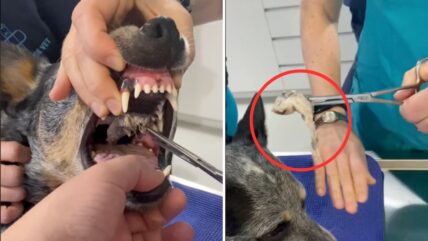This Frenchie’s Legs Were Backward. Learn More About Swimmers Syndrome
Puppies born with birth defects often face challenging odds, with many losing their lives to their conditions or being euthanized in shelters. Phelps, a French Bulldog with swimmer syndrome, was one such puppy. Born with splayed back legs that left him unable to walk, his future seemed uncertain.
@thedodo With @Kathryn Hartwig ♬ original sound – The Dodo
That changed when Kathryn Hartwig, a licensed veterinary technician with a passion for special-needs dogs, took him in. Determined to give Phelps a fighting chance, she has devoted herself to his care and rehabilitation.
Rehab Is Phelps’ Only Hope
Born with hind limbs that are nearly fully backward, Phelps laid flat like a pancake. Hartwig tells in a TikTok video that the Frenchie requires months of rehab to get his legs in a normal shape.

Phelps has already made remarkable progress, even managing to stand on his own at times. Hartwig remains hopeful that with time, dedication, and continued support, Phelps will one day run and play like any other dog.
Swimmer Legs Made Him Viral

Shared by The Dodo, Phelps’ video has gone viral on TikTok with millions of views and over 1 million likes. Additionally, thousands of comments poured in, evidently touched by the dog’s story.
A user, Ava wrote, “I would do anything for Phelps”. Meanwhile, another user added, “Aw he’s so cute hope he’s doing well.”
With Hartwig’s efforts, Phelps will likely have a shot at a normal life. But many pet parents can’t help but wonder about his condition, swimmer’s syndrome in dogs.

What is Swimmer Syndrome in Dogs?
Swimmer syndrome is different than swimmer tail syndrome, which is a medical condition causing a dog’s tail to hang limply or extend straight before dropping. On the other hand, puppies with swimmer syndrome or flat puppy syndrome often experience underdeveloped tension in their tendons and muscles.
As per Veterinarian Dr. Madison Ricard, “Instead of the legs moving under the body ready for standing and walking, the legs remain splayed out beside or behind the body. Without early treatment, puppies with swimmer syndrome are permanently unable to walk.”
In severe cases, swimmer syndrome can lead to life-threatening developmental complications in other parts of the body. Swimmer syndrome in puppies is a relatively rare condition. If a puppy is unable to walk or support its own weight by 20 days old, it requires immediate veterinary attention. Swimmer syndrome tends to affect smaller dog breeds more frequently.
Symptoms of Swimmer Syndrome
The most distinctive symptom in dogs with swimmer syndrome is their inability to stand, support their weight, or walk, characterized by legs that lie flat on the ground beside or behind their body.
Causes of Swimmer Puppy Syndrome

Dr. Emmanuel Fontaine shared a blog about swimmer’s syndrome in dogs and how is it caused, explaining that swimmer puppy syndrome is a complex condition influenced by genetics, environmental factors, and breed-specific characteristics. To comprehend why some puppies are more susceptible to this syndrome, let’s delve into each of these aspects.
Genetic Factors
While the genetic basis of swimmer puppy syndrome is not fully understood, research suggests a hereditary component. Certain breeds, such as English Bulldogs, Golden Retrievers, and Labrador Retrievers show a higher incidence of the syndrome, implying a possible genetic predisposition.
Studies have also found that puppies from the same litter can be variably affected, further supporting genetic influences. Although a definitive genetic marker has not been identified, breed-specific tendencies and familial occurrences suggest an underlying genetic basis.
Environmental Influences
Environmental factors play a significant role in the development of swimmer puppy syndrome. For instance, puppies raised on slippery surfaces may struggle to gain traction, leading to abnormal leg movement and posture development.
Larger or heavier puppies, or those experiencing rapid weight gain, may be more susceptible due to increased strain on their developing musculoskeletal system.
Breed-Specific Tendencies
Certain breeds are more prone to developing swimmer pup syndrome due to a combination of genetic and physical characteristics.
Brachycephalic breeds like English Bulldogs have a unique body structure that may predispose them to this condition. The physical build of a breed can affect how puppies learn to move and support their weight, potentially contributing to the development of swimmer syndrome.
Diagnosis of Swimmer Syndrome
A comprehensive physical examination is the initial step in diagnosing Swimmer Puppy Syndrome. This examination involves carefully observing the puppy’s posture, position of limbs, and movements.
When identifying swimmer puppy syndrome, it’s essential to recognize the characteristic signs. One of the most notable indicators is if the puppy is unable to stand or walk properly.
Another distinctive feature is the positioning of the limbs, which are often splayed out to the sides. Additionally, when attempting to move, affected puppies typically exhibit paddling motions.
Swimmer Syndrome Puppy Treatment
A Reddit user, u/Pablois4, provides a treatment option for swimmer syndrome puppy, saying, “The tying of the legs is a time-tested method of helping correct the problem. It’s important to tape them correctly and if taped correctly, there’s no danger to the pup and he can wear it 24/7. Every day it needs to be checked for proper fit.”
According to Dr. Ricard, recovery from Swimmer Puppy Syndrome requires a combination of treatments, including binding and hobbling, slinging, massage, and physical therapy. The primary objectives of treatment are to keep the puppy’s legs in the proper position, encourage weight-bearing and walking, and develop tension and tone in the muscles and tendons.
Physical Therapy Techniques
Techniques used in physical therapy include:
- Taping the knees and ankles into the proper position
- Connecting the legs
- Using a sling or harness to support the puppy’s weight
- Exercising the muscles with the help of a sling
- Moving the limbs through their full range of motion
- Massaging and stimulating the legs and feet
- Exercising in water (after 6 weeks of age)

To ensure a smooth recovery for the affected pup, consider providing flooring with traction, such as carpet, to prevent slipping, using soft, supportive bedding, and maintaining good hygiene practices, as affected puppies may have difficulty moving to urinate or defecate.
Without treatment, puppies with swimmer syndrome may never learn to walk or support their own weight, leading to fatal complications. However, with early and consistent treatment, the prognosis for a full recovery is good. Once the puppy can walk independently, its life expectancy is the same as other dogs with normal development.






